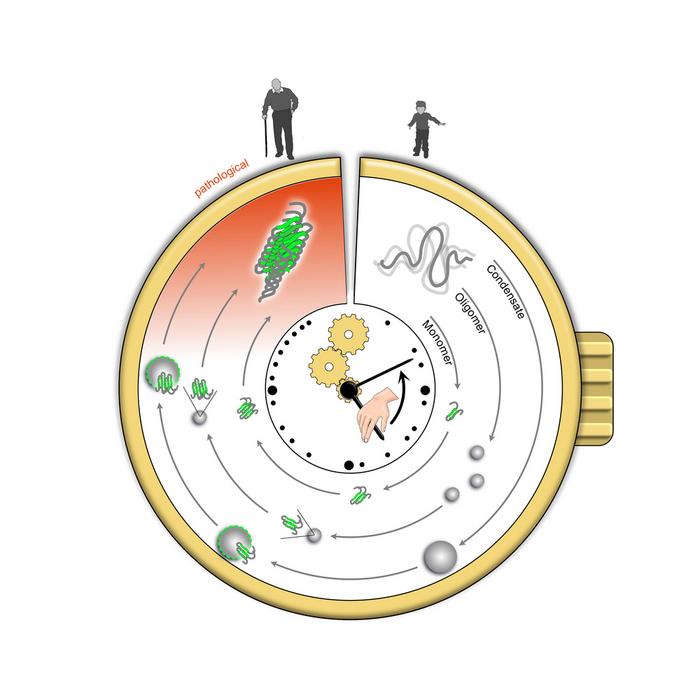— JOINT PRESS RELEASE OF THE INSTITUTE OF MOLECULAR BIOLOGY (IMB) AND JOHANNES GUTENBERG UNIVERSITY MAINZ —

Credit: ill./©: Nike Heinss / JGU
— JOINT PRESS RELEASE OF THE INSTITUTE OF MOLECULAR BIOLOGY (IMB) AND JOHANNES GUTENBERG UNIVERSITY MAINZ —
Could measuring protein clumps in our cells be a new way to find out our risk of getting age-related diseases? Professor Dorothee Dormann and Professor Edward Lemke of Johannes Gutenberg University Mainz (JGU), who are also adjunct directors at the Institute of Molecular Biology (IMB) in Mainz, propose the concept of a “protein aggregation clock” to measure ageing and health in a new perspective article published in Nature Cell Biology.
As we age, the DNA and proteins that make up our bodies gradually undergo changes that cause our bodies to no longer work as well as before. This in turn makes us more prone to getting age-related diseases, such as cardiovascular disease, cancer, and Alzheimer’s disease. One important change is that the proteins in our cells can sometimes become misfolded and clump together to form aggregates, so-called amyloids. Misfolding and aggregation can happen to any protein, but a specific group of proteins known as intrinsically disordered proteins (IDPs) are especially prone to forming amyloids. IDPs make up around 30 percent of the proteins in our cells and they are characterized by having no fixed structure. Instead, they are flexible and dynamic, flopping around like strands of cooked spaghetti.
While the molecular mechanisms are widely debated and an important aspect of basic research, scientists know that aggregates formed from IDPs tend to accumulate in many long-lived cells – such as neurons or muscle cells – as we age. Moreover, they can cause many age-related diseases, particularly neurodegenerative diseases such as Alzheimer’s and Parkinson’s disease. Thus, having many aggregates in a cell could be an indicator of how unhealthy the cell is or if a person is likely to develop an age-related disease soon. In their recently published article, Dormann and Lemke propose that IDP aggregation could be used as a biological “clock” to measure a person’s health and age.
If developed further into a sensitive diagnostic test, a protein aggregation clock could be extremely useful. Firstly, doctors could use it to help diagnose age-related diseases at very early stages or identify people who are not yet sick but have a higher risk of developing disease as they age. This would allow them to be given preventative treatments before they develop severe disease. Secondly, scientists could use it to assess the effects of new experimental treatments to reduce protein aggregation in order to prevent or delay age-related diseases.
“In practice, we are still far away from a routine diagnostic test, and it is important that we improve our understanding of the fundamental mechanisms leading to IDP aggregation”, said Dormann. “However, we want to stimulate thinking and research in the direction of studying protein aggregates to measure biological ageing processes,” Lemke added. “We are optimistic that in the future we will be able to overcome the current challenges of reading a protein aggregation clock through more research on IDP dynamics and making further technological developments.”
Although there are other “clocks” to measure ageing and health, most of them are based on nucleic acids like DNA. Dormann and Lemke think that a biological clock based on proteins would be a useful complement to these existing clocks, as proteins are among the most abundant molecules in cells and are crucial for all cellular functions. With the help of such a protein aggregation clock, they hope that scientists and doctors will be able to move one step closer towards helping people age healthily and preventing age-related diseases.
With their research, Dorothee Dormann and Edward Lemke contribute to the Center for Healthy Ageing (CHA), a virtual research center launched in 2021. The CHA brings together scientists in basic and clinical research from across Mainz who focus on ageing and age-related diseases. Their findings are to be used to promote healthy ageing and to find treatments that help prevent or cure age-related diseases.
Related links:
- – Professor Dorothee Dormann at the Institute of Molecular Biology (IMB)
- – Lab of Professor Lemke at the JGU and the Institute of Molecular Biology (IMB)
Contact:
Professor Dr. Dorothee Dormann
Molecular Cell Biology
Institute of Molecular Physiology (IMP)
Johannes Gutenberg University Mainz
55099 Mainz, GERMANY
and
Institute of Molecular Biology (IMB)
55128 Mainz, GERMANY
phone: +49 6131 39-36206
e-mail: ddormann@uni-mainz.de
Professor Dr. Edward Lemke
Synthetic Biophysics
Institute of Molecular Physiology (IMP)
Johannes Gutenberg University Mainz
55099 Mainz, GERMANY
and
Institute of Molecular Biology (IMB)
55128 Mainz, GERMANY
phone: +49 6131 39-36118
e-mail: edlemke@uni-mainz.de
Read more:
- – press release “Dorothee Dormann receives an ERC Consolidator Grant to support her research into neurodegenerative diseases” (5 Dec. 2023)
- – press release “How wiggly spaghetti guard the genome” (27 Apr. 2023)
- – press release “Understanding cellular functions: New Collaborative Research Center combines life sciences and polymer research” (2 Dec. 2022)
- – JGU Magazine: “The search for causes of neurodegenerative diseases” (8 Feb. 2022)
- – press release “Dorothee Dormann and Rosa Rademakers collaborate in a research project on rare forms of dementia” (1 Feb. 2022)
- – press release “Edward Lemke receives funding from the Volkswagen Foundation for his work on the replication of cellular processes using new forms of organelles” (6 Sept. 2021)
Journal
Nature Cell Biology
Article Title
Adding intrinsically disordered proteins to biological ageing clocks
Article Publication Date
23-May-2024



